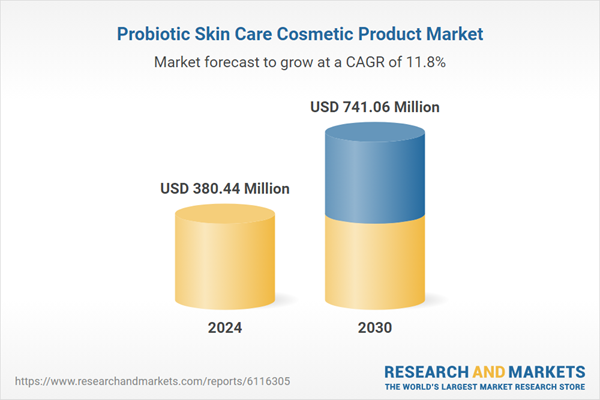Speak directly to the analyst to clarify any post sales queries you may have.
10% Free customizationThis report comes with 10% free customization, enabling you to add data that meets your specific business needs.
Market Drivers
Growing Consumer Preference for Natural and Clean Beauty Products
One of the primary drivers of the probiotic skin care cosmetic product market is the increasing consumer demand for natural, clean, and chemical-free beauty products. In recent years, there has been a significant shift in consumer preferences towards products that are perceived as safer, eco-friendly, and more in tune with the body's natural processes. Probiotic skin care fits perfectly into this trend, as it incorporates live beneficial bacteria or bacterial extracts to help balance the skin’s microbiome and improve skin health naturally. Consumers are becoming more educated and conscious about what they apply to their skin.They are seeking alternatives to conventional cosmetics that often contain harsh chemicals, preservatives, and synthetic fragrances. This demand for transparency and health-oriented products is fueling the rise of probiotic-based cosmetics. These formulations are promoted as gentle and suitable for sensitive skin, making them appealing to a broad audience. Furthermore, the wellness movement focusing on holistic health has integrated into the beauty industry, reinforcing the belief that healthy skin starts with a balanced microbiome. As people connect gut health and overall wellness with skin care, probiotics have gained a reputation as both an internal and external solution. This convergence of clean beauty, wellness, and natural formulation preferences continues to push the growth of the probiotic cosmetic market globally.
Key Market Challenges
Product Stability and Shelf Life Issues
One of the key challenges facing the probiotic skin care market is ensuring product stability and shelf life. Live probiotics are sensitive organisms that require specific conditions to remain active and effective. Exposure to air, light, temperature fluctuations, and certain preservatives can degrade these beneficial bacteria, reducing their efficacy before the product is even used by consumers.Many probiotic skin care products claim to contain live cultures, but without proper formulation techniques and packaging solutions, these claims may not hold true throughout the product's shelf life. This creates a significant hurdle for manufacturers, who must invest in specialized encapsulation technologies or refrigeration methods to ensure probiotics remain viable. Inconsistent quality can lead to consumer disappointment and mistrust, especially if the promised benefits are not delivered. Furthermore, regulatory bodies in some regions are beginning to scrutinize the use of the term "probiotic" in non-ingestible products, requiring evidence that live microbes are present and beneficial at the time of use.
Key Market Trends
Integration of Prebiotics and Postbiotics in Formulations
A significant trend in the probiotic skin care market is the growing integration of prebiotics and postbiotics alongside probiotics in product formulations. While probiotics introduce beneficial bacteria to the skin, prebiotics act as food sources that nourish existing good bacteria, and postbiotics are the byproducts of probiotic activity that also offer skin benefits. This synergistic combination is increasingly being adopted by skincare brands to enhance the efficacy and appeal of their microbiome-focused products. As consumer awareness grows around microbiome health, there is a rising demand for multi-functional solutions that support the skin’s ecosystem in more comprehensive ways.Products containing all three components - probiotics, prebiotics, and postbiotics - are seen as more effective in restoring balance, improving skin resilience, and addressing common concerns such as dryness, irritation, and acne. This trend is also driven by advancements in dermatological research, which supports the role of these ingredients in maintaining the skin’s barrier function and preventing inflammation. Brands are using this science-backed approach to differentiate their products and justify premium pricing.
Key Market Players
- Esse Skincare
- Eminence Organic Skincare
- Estee Lauder Companies, Inc.
- Unilever plc
- Aurelia Skincare Ltd.
- LaFlore Probiotic Skincare
- L’oreal S.A.
- Glowbiotics, Inc.
- Tula Life, Inc.
- The Clorox Company
Report Scope:
In this report, the global Probiotic Skin Care Cosmetic Product Market has been segmented into the following categories, in addition to the industry trends which have also been detailed below:Probiotic Skin Care Cosmetic Product Market, By Product Type:
- Cleaner
- Moisturizer
- Serum
- Masks
- Others
Probiotic Skin Care Cosmetic Product Market, By End User:
- Men
- Women
- Unisex
Probiotic Skin Care Cosmetic Product Market, By Distribution Channel:
- Supermarkets/Hypermarkets
- Specialty Stores
- Department Stores
- Online
- Others
Probiotic Skin Care Cosmetic Product Market, By Region:
- North America
- United States
- Canada
- Mexico
- Europe
- France
- Germany
- Spain
- Italy
- United Kingdom
- Asia-Pacific
- China
- Japan
- India
- Vietnam
- South Korea
- Middle East & Africa
- South Africa
- Saudi Arabia
- UAE
- Turkey
- South America
- Brazil
- Argentina
- Colombia
Competitive Landscape
Company Profiles: Detailed analysis of the major companies present in the global Probiotic Skin Care Cosmetic Product Market.Available Customizations:
With the given market data, the publisher offers customizations according to a company's specific needs. The following customization options are available for the report.Company Information
- Detailed analysis and profiling of additional market players (up to five).
This product will be delivered within 1-3 business days.
Table of Contents
Companies Mentioned
- Esse Skincare
- Eminence Organic Skincare
- Estee Lauder Companies, Inc.
- Unilever plc
- Aurelia Skincare Ltd.
- LaFlore Probiotic Skincare
- L’oreal S.A.
- Glowbiotics, Inc.
- Tula Life, Inc.
- The Clorox Company
Table Information
| Report Attribute | Details |
|---|---|
| No. of Pages | 185 |
| Published | August 2025 |
| Forecast Period | 2024 - 2030 |
| Estimated Market Value ( USD | $ 380.44 Million |
| Forecasted Market Value ( USD | $ 741.06 Million |
| Compound Annual Growth Rate | 11.8% |
| Regions Covered | Global |
| No. of Companies Mentioned | 10 |









